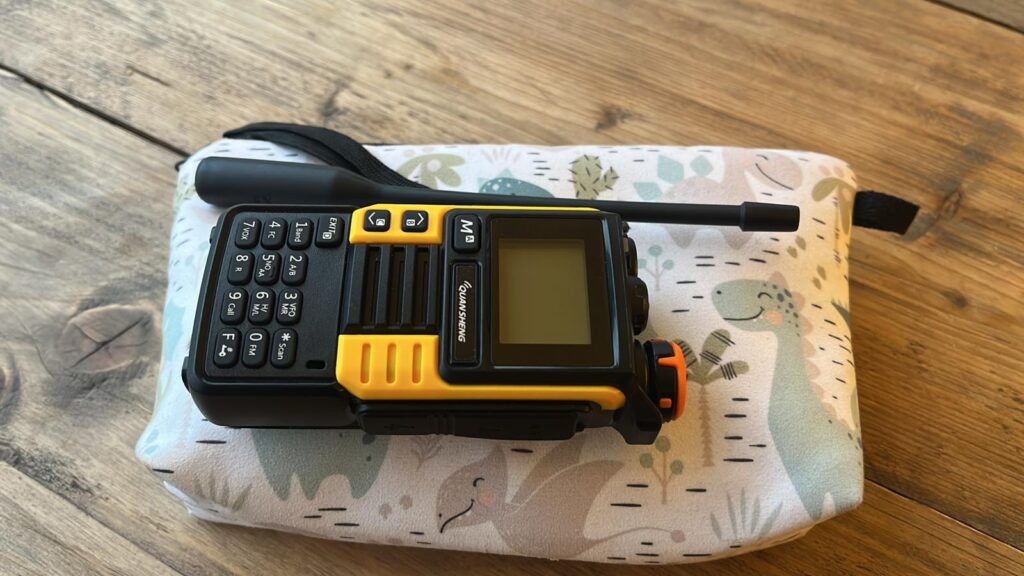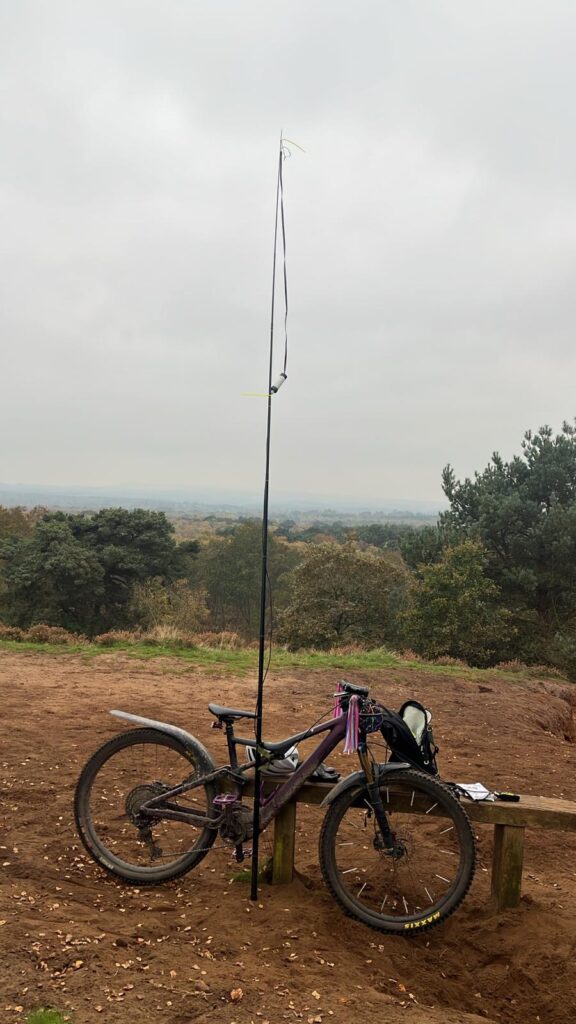It was time to pick a small birthday present for a freshly starting radio amateur. The decision was made towards an inexpensive handheld radio for both the 2 meter and 70 centimeter band. While in the past, the Baofeng UV-5R was THE cheap handheld radio to go for, this seems to have changed now, and many people recommend the Quansheng radio. Therefore, we decided to gift the Quansheng radio.
I found many contradictory statements online about different model versions of the K5 / K6 and which model would be better for what use cases. Finally I found out from people who opened and compared the PCBs in those radios that: They are all the same! There is no difference in technical specifications between the models K5, K5(8), K5(99) and K6. Actually they do differ in one technical aspect: The background color of the built in LCD Display. If that is something that is important to you, get the model with the backlight color you need. Unlike some statements elsewhere, the background color is not defined by software and therefore can not be freely changed to anything you want. But besides that, the radios only slightly vary in optics.

Obtaining the radio
Quansheng is, as it the name sounds, a chinese brand. While you might be able to buy the radio from local sellers, they will have imported the radio from china in the first place too. I therefore opted to skip the middle-man and order directly from china, to save money.
Back in the days, when importing from china yourself, you needed to deal with complications like import taxes / VAT. Since July 2021, an EU-Law is forcing sellers from outside the EU to collect and pay VAT directly. While this led to a beefy price increase for goods on platforms like AliExpress, it also removed the “surprise” of paying taxes and fees upon delivery. When shipping to Germany, AliExpress displays all prices with VAT already included and when shipping to the UK, upon checkout you get the additional taxes shown.
Still with the added taxes, I found this radio to be much cheaper when buying from AliExpress, than when buying from a local seller. I therefore went for the UV-K6 (because parts of the housing are yellow) and ordered at AliExpress. Including shipping to the UK I payed ~23€ / ~ £20. 5 Days after I placed the order, the radio arrived at my doorstep
The radio and accessoires
The radio arrived in a cardboard box, together with a rubber antenna, a USB-Charging Cable, a belt clip, a short lanyard for your wrist, an earpiece (never tried that – don’t have high expectations), and a charging cradle to charge the radio from mains power. For the mains charger I was only able to select a US or an EU-Plug, so a UK adapter has to be obtained separately.
The radio claims to transmit with up to 5 Watts. As with all claims from chinese products I recommend to take them with a grain of salt, but other reviews indicate, that this is not too far off. It is advertised to receive from 20MHz up to 2GHz, which sounds impressive at first, but don’t expect the radio to be sensitive on those bands at all. Just because the software allows you to dial in a frequency does not at all imply that the radios hardware is capable of sufficiently demodulate on those frequencies. If you are looking for a cheap broad band receiver, I would not recommend this radio purely based on those claims. Instead I recommend that radio to only be used on the ham radio frequencies in the 2 Meter and 70cm bands.
The radio can be configured through free and open source software called CHIRP, that runs on Windows, Mac and Linux machines. It makes configuring the radio, especially storing repeater information in its memory much easier. A programming cable for this radio needs to be obtained separately, but can be found for ~ 2€ / ~ £1.50 from China as well.
The radio can of course not compete with the ones reputable brands have to offer. But the huge difference in price makes those cheap radios interesting again. Don’t expect a great speaker or a professional microphone built into those radios. Also you might want to measure the harmonics that those radios send out and double-check your local rules about them!
Why I chose this radio: Custom Firmware
The main point for me choosing this radio besides any other cheap ones: There is custom, community developed firmware available that can heavily enhance this radios features.
There are different community managed firmware versions available with different, but overlapping features added. A nice comparison table that I found and that helped me deciding on which firmware to go for, is here: https://docs.google.com/spreadsheets/d/1XC7qwNhlAGdnbr8AOzWFWvPD_WFv6WIrd39VeX5mUFI
I went for the F4HWN-Firmware as it adds the most features that are interesting to me, but if you wish for the radio to support more modes like FT-8, CW, SSTW or ARPS, maybe the CEC Firmware is a better fit for you. (Never tested that, can’t say anything about it).
The radio can be flashed via a web browser, so it neither requires you to have any software installed, or limits you on certain operating systems to be used. Be aware, that the default CHIRP driver for this radio will not work any more. At least for F4HWN (and I guess for others too), you need to download a separate file to make the radio work with CHIRP again.
Due to the limited physical storage built into the radio, firmware files can’t grow indefinitely and are VERY limited in size. Therefore you won’t find a firmware that brings all the community features at one. Even with the F4HWN firmware you will lose some stock features of the radio (like listening to FM broadcast radio). But it comes with awesome new features like a spectrum analyzer, some super low power modes and an improved UI layout with new shortcut key functions.
Custom firmware allows you to transmit on more bands than the radio was designed for / a radio amateur is allowed to. Just because the Software allows it, does not mean that a) it is legal, nor b) that the radio hardware was built for it. Especially for lower frequencies you risk damaging the radio, and transmit harmonics that are stronger than the actual signal you trying to send!
Bonus: Hardware modification
There is a hardware modification that claims to allow receiving on HF. For that you need to obtain a separate PCB and solder it onto the radio. It comes with a separate antenna connector, that requires you to remove the LED on top of the radio.
I have not yet tested that modification myself. From what I have heard, this does improve HF RX compared to tune the existing hardware to the HF-Spectrum, but can not compare with a dedicated HF radio. When going for that modification, you will need to go for custom software too.
While you can buy the Quansheng UV-K5 / UV-K6 radios with that PCB pre-installed, I found multiple reports online of customers that opened the radio and figured out, that the board was in-fact not installed and they got scammed. I therefore recommend to either solder the board yourself, or buy from a local shop, where you can file a complaint that can’t be ignored.
The modification board seems to be based on the SI4732 IC. The data sheet of that IC lists a possible frequency range from 2.3 MHz up to 26.1 MHz, as well as 64 MHz up to 108 MHz. During my short research I did not find out why the frequency range of 26 MHz up to 64 MHz is not listed on the data sheet. As this chip is programmable, it might well be possible that through custom software a decent enough reception of the whole HF-Band is possible.
The SI4732 Quansheng modification board can be obtained for around 10€ – 20€ / £8 – £13 from AliExpress.
Conclusion
While I have not yet used that radio a lot, it seems to qualify as a small and cheap item to always carry with you. When hiking through more rough nature or mountains, I don’t need to be too afraid of damaging or losing an expensive piece of equipment. Breaking a Quansheng UV-K6 is a financially completely different story, compared to a YAESU FT-818nd.
But: Whenever space and weight constraints allow it, I so far still prefer the FT-818 for the ability to RX and TX on many more bands. I have not measured the RX sensitivity of both radios but would assume that the FT-818 would win there too. When traveling by car, the FT-818 stays my companion, but if on hikes I only need a way to communicate with another group of friends in the area, the Quansheng UV-K6 might be a more lightweight option.
The giftee uses the Quansheng UV-K6 on mountain bike trips, where the where the weight and robustness of the radio comes into its own.

